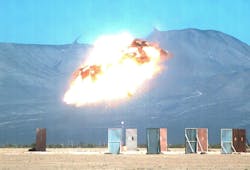Lockheed Martin to build GMLRS artillery smart munitions with fragmentation warheads in $2.8 billion deal
REDSTONE ARSENAL, Ala. – Battlefield weapons experts at Lockheed Martin Corp. are building smart munitions for the Guided Multiple Launch Rocket System (GMLRS) field artillery for the U.S. Army.
Officials of the U.S. Army Contracting Command at Redstone Arsenal, Ala., are asking the Lockheed Martin Missiles and Fire Control segment in Grand Prairie, Texas, to build the smart GMLRS rockets and support equipment under terms of $2.8 billion contract announced Friday.
Lockheed Martin will build GMLRS Alternative Warhead rocket pods, GMLRS unitary warhead rocket pods, low-cost reduced range practice rocket pods, cyber security services, integrated product support, and other services.
The GMLRS Alternative Warhead can engage the same targets and achieve the same area-effects as the old MLRS submunition warheads, but without the lingering danger of unexploded ordnance, Lockheed Martin officials say.
The system's Alternative Warhead rocket is a large airburst fragmentation warhead that explodes about 30 feet over a target area to disperse solid-metal penetrating projectiles to destroy enemy soldiers, armored vehicles, command posts, and other battlefield targets.
GMLRS Alternative Warhead rockets are all-weather, time-critical, rapidly deployable guided munitions that offer precision area-effects capability. The munitions comply with international treaties banning submunition weapons, and enables all users of the MLRS to have an area-effects weapon in their inventories without the need to procure additional launcher systems.
The GMLRS can fire guided and unguided projectiles at targets as far away as 26 miles. The system also can fire the Army Tactical Missile System (ATACMS) at targets as far away as 190 miles. The rocket-based artillery system also can fire its munitions quickly and the move away to avoid counter-battery fire.
The GMLRS carries its guided munitions in pods that contain six rockets. Each system carries two pods that must be loaded by hand. GMLRS can fire all of its 12 munitions in less than a minute.
The GMLRS unitary-warhead rocket is a GPS-guided munition with a 200-pound high-explosive warhead that can be used on open battlefields and in urban areas. Its guidance system enables the rocket to avoid causing collateral damage, and enables GMLRS crews to fire fewer rockets.
The unitary-warhead GMLRS rocket has a multi-mode fuse for point detonation, delay detonation, and proximity detonation to attacking soft targets, lightly fortified bunkers, and enemy personnel in the open.
On this contract Lockheed Martin will do the work at locations to be determined with each order, and should be finished by October 2024. For more information contact Lockheed Martin Missiles and Fire Control online at www.lockheedmartin.com/us/mfc.html, or the Army Contracting Command-Redstone at http://acc.army.mil/contractingcenters/acc-rsa.
About the Author
John Keller
Editor-in-Chief
John Keller is the Editor-in-Chief, Military & Aerospace Electronics Magazine--provides extensive coverage and analysis of enabling electronics and optoelectronic technologies in military, space and commercial aviation applications. John has been a member of the Military & Aerospace Electronics staff since 1989 and chief editor since 1995.
